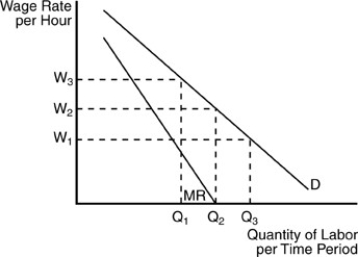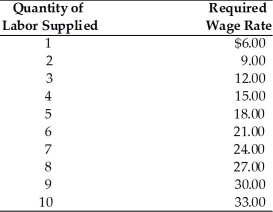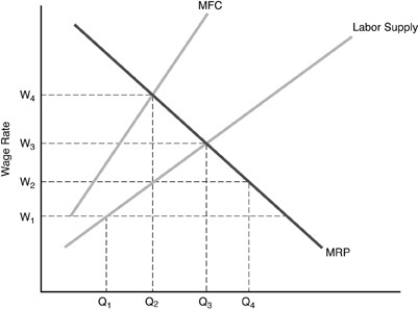A) Unionism raises social efficiency.
B) Unions appear to reduce wage inequality.
C) Unions may reduce a company's profits.
D) Unions may have contributed to safer working conditions.
Correct Answer

verified
Correct Answer
verified
Multiple Choice
Which of the following type of shops is unlawful under the provisions of the Taft-Hartley Act?
A) union shops
B) closed shops
C) modified union shops
D) open shops
Correct Answer

verified
Correct Answer
verified
Multiple Choice
In order to hire additional laborers, a monopsony must
A) lower the supply of labor.
B) raise the wage rate.
C) advertise for the labor.
D) do nothing.
Correct Answer

verified
Correct Answer
verified
Multiple Choice
Currently about what percentage of the civilian labor force is unionized in the United States?
A) 6 percent
B) 12 percent
C) 30 percent
D) 70 percent
Correct Answer

verified
Correct Answer
verified
Multiple Choice
If a union establishes by collective bargaining a wage rate that is above a competitive market equilibrium wage rate, then
A) an excess quantity of labor will be supplied.
B) a shortage of labor will result.
C) there will be an increase in total employment.
D) management will want to substitute labor for machinery.
Correct Answer

verified
Correct Answer
verified
Multiple Choice
Under monopsony, the marginal factor cost of a worker is equal to
A) the additional worker's wage rate only.
B) the additional worker's wage rate plus the increase in the wages of all other existing workers.
C) the increase in the wages of all other existing workers.
D) the difference between the worker's wage rate and the lower wage rate received by workers who have already been hired.
Correct Answer

verified
Correct Answer
verified
Multiple Choice
 -Consider the above figure, which displays the situation faced by a union employed by a firm with the labor demand curve D. This union has total membership of Q3 workers, but its single wage setting goal is to maximize wages for the Q1 members with the most seniority. If the union managers accomplish this goal, what occurs?
-Consider the above figure, which displays the situation faced by a union employed by a firm with the labor demand curve D. This union has total membership of Q3 workers, but its single wage setting goal is to maximize wages for the Q1 members with the most seniority. If the union managers accomplish this goal, what occurs?
A) All of the union members will be employed at the wage rate W3.
B) All of the union members will be employed at the wage rate W1.
C) The senior members of the union will receive a wage equal to W3, but Q3 union members will be unemployed.
D) The select group of senior union members will have work and receive a wage of W3, but Q3 -Q1 union members will not be employed by the firm.
Correct Answer

verified
Correct Answer
verified
Multiple Choice
A monopsonistic employer will pay a wage rate
A) less than the labor's MRP.
B) greater than the labor's MRP.
C) equal to the labor's MRP.
D) equal to MFC.
Correct Answer

verified
Correct Answer
verified
Multiple Choice
A right-to-work law is
A) a federal law making the closed shop illegal.
B) a federal law making the union shop illegal.
C) a state law making the union shop illegal.
D) a state law making the open shop illegal.
Correct Answer

verified
Correct Answer
verified
Multiple Choice
The National Labor Relations Act (Wagner Act)
A) prohibited the creation of company unions.
B) guaranteed workers the right to organize.
C) set the minimum wage at $5.15 an hour.
D) set the length of the workweek at 40 hours.
Correct Answer

verified
Correct Answer
verified
Multiple Choice
Economists argue that the union wage advantage
A) has been estimated to be 100% in the private sector.
B) in the private sector is a 4% increase in wages for union workers over nonunion workers.
C) reached its height in 2000 in the private sector.
D) has been close to zero since World War II in the private sector.
Correct Answer

verified
Correct Answer
verified
Multiple Choice
 -From the information in the above table, calculate the marginal factor cost of the third worker.
-From the information in the above table, calculate the marginal factor cost of the third worker.
A) $24.00
B) $36.00
C) $18.00
D) $12.00
Correct Answer

verified
Correct Answer
verified
Multiple Choice
Suppose that under its collective bargaining agreement the XYZ Corp. can hire nonunion workers, but these workers must join the union within 60 days. This agreement is an example of
A) an open shop.
B) a closed shop.
C) a company union.
D) a union shop.
Correct Answer

verified
Correct Answer
verified
Multiple Choice
 -In the above figure, what is the wage rate for the perfectly competitive market?
-In the above figure, what is the wage rate for the perfectly competitive market?
A) ![]()
B) ![]()
C) ![]()
D) ![]()
Correct Answer

verified
Correct Answer
verified
Multiple Choice
The Taft-Hartley Act outlawed all of the following practices EXCEPT
A) secondary boycotts.
B) union shops.
C) closed shops.
D) sympathy strikes.
Correct Answer

verified
Correct Answer
verified
Multiple Choice
Which of the following best describes the effects of unions in the United States today?
A) The average union worker works more hours but earns a lower annual income than the average nonunion worker.
B) The average union worker works fewer hours but earns a higher annual income than the average nonunion worker.
C) The average union worker works more hours and earns a higher annual income than the average nonunion worker.
D) The average union worker works fewer hours and earns a lower annual income than the average nonunion worker.
Correct Answer

verified
Correct Answer
verified
Multiple Choice
Suppose a union successfully negotiates a wage rate for its members that is above the competitive wage rate, then
A) employment in the union sector will increase.
B) the union must find a way to make union workers more productive.
C) the union must also negotiate a fringe-benefit package that the membership will like.
D) the union must find a way to ration jobs among the excessive number of workers who wish to work at the negotiated wage.
Correct Answer

verified
Correct Answer
verified
Multiple Choice
The United Steelworkers is an example of a(n)
A) craft union.
B) industrial union.
C) public-sector union.
D) guild.
Correct Answer

verified
Correct Answer
verified
Multiple Choice
Which statement is most TRUE about the impact of unions on wage levels in the Untied States?
A) Unions have had no impact on the wage levels of their workers.
B) Unions have tended to increase the hourly wage rates of their members relative to nonunion workers by an average of about $2.25.
C) Unions have contributed to increased income inequality in the United States by raising corporate profits.
D) The union/nonunion wage differential tends to decrease during a recession.
Correct Answer

verified
Correct Answer
verified
Multiple Choice
 -Use the above table. The MFC of the 3rd worker is
-Use the above table. The MFC of the 3rd worker is
A) $5.
B) $30.
C) $20.
D) $6.7.
Correct Answer

verified
Correct Answer
verified
Showing 201 - 220 of 318
Related Exams